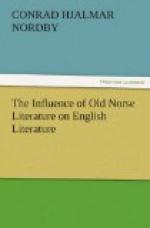An example of the publishers’ feeling that the reading public will find an interest in the saga itself, is the translation of Laxdaela Saga by Muriel A.C. Press (London, 1899, J.M. Dent & Co.). William Morris made this saga known to readers of English poetry by his magnificent “Lovers of Gudrun.” Mrs. Press lets us see the story in its original form. Perhaps this translation will appeal as widely as any to those who read, and we may note the differences between this form of writing and that to which the modern times are accustomed.
This saga is a story, but it is not like the work of fiction, nor like the sketch of history which appeals to our interest to-day. It has not the unity of purpose which marks the novel, nor the broad outlook over events which characterizes the history. Plotting is abundant, but plot in the technical sense there is none. Events are recorded in chronological order, but there is no march of those events to a denouement. While it would be wrong to say that there is no one hero in a saga, it would be more correct to say that that hero’s name is legion. From generation to generation a saga-history wends its way, each period dominated by a great hero. The annals of a family edited for purposes of oral recitation, or the life of the principal member of that family with an introduction dealing with the great deeds of as many of his ancestors as he would be proud to own—this seems to be what a saga was—Laxdaela, Grettla, Njala.
This form permits many sterling literary qualities. Movement is the most marked characteristic. This was essential to a spoken story, and the sharpest impression left in the mind of an English reader is that of relentless activity. Thus he finds it necessary to keep the bearings of the story by consulting the list of dramatis personae and the map, both indispensable accompaniments of a saga-translation. The chapter headings make this list, and a glance at them for Laxdaela reveals a procession of notable personages—Ketill, Unn, Hoskuld, Olaf the Peacock, Kiartan, Gudrun, Bolli, Thorgills, Thorkell, Thorleik, Bolli Bollison and Snorri. Each of these is, in turn, the center of action, and only Gudrun keeps prominent for any length of time.
Character-portraiture, ever a remarkable achievement in literature, is excellently done in the sagas. There was a necessity for this; so many personages crowded the stage that, if they were not to be mere puppets, they would have to be carefully discriminated. That they were so a perusal of any saga will prove.




